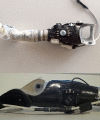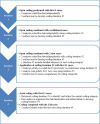User experience of controlling the DEKA Arm with EMG pattern recognition
- PMID: 30240420
- PMCID: PMC6150511
- DOI: 10.1371/journal.pone.0203987
User experience of controlling the DEKA Arm with EMG pattern recognition
Abstract
Introduction: A commercially available EMG Pattern Recognition (EMG-PR) control system was adapted to interface with the multi-degree of freedom (DOF) DEKA Arm.
Purpose: To describe users' experience of controlling the DEKA Arm using EMG-PR.
Methods: Sample: Twelve persons with upper limb amputation participated, 10 with transradial (TR), 2 with transhumeral (TH) level amputation. Ten were male, and 11 were users of a prosthesis at baselines. Design: This was a two-part study consisting of in-laboratory prosthetic training (Part A) and up to 12 weeks of home use of the prosthesis (Part B). Data collection: Qualitative data were collected through open-ended survey questions and semi-structured interviews. Data Analysis: The study used a qualitative case series design with a constant comparative approach to identify common categories of experience. Coding categories were iteratively refined until saturation of categories was achieved. The data were organized in a primary category, major categories of experience, factors impacting experience, and broader contextual factors.
Results: Users had mixed perspectives on the desirability of the EMG-PR control system in combination with the DEKA Arm. Major aspects of user experience related to the system complexity, process of calibrating, and functional benefits. Factors influencing user experience included training and acclimation, fatigue, prosthesis design, technical issues and control changes. Broader contextual factors, both personal and environmental, also impacted users' experience.
Discussion/conclusion: This study provided an in-depth description of user experience operating the DEKA Arm using EMG-PR control. The majority of participants expressed a preference for the controls of their personal prosthesis and controls rather than the iteration of EMG-PR controlled DEKA Arm used in this study. Most were positive about the future potential of EMG-PR as a control method. An understanding of patient experience will assist clinicians and patients choosing prosthetic options.
Conflict of interest statement
The authors have declared that no competing interests exist.
Figures
References
-
- Phillips SL, Resnik L, Fantini C, Latlief G. Endpoint Control for a Powered Shoulder Prosthesis. J ProsthOrthotics. 2013;25(4):8.
Publication types
MeSH terms
Grants and funding
LinkOut - more resources
Full Text Sources
Other Literature Sources
Medical
Research Materials




